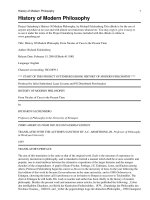Microwave-assisted synthesis of nanorod hydroxyapatite from eggshells
Bạn đang xem bản rút gọn của tài liệu. Xem và tải ngay bản đầy đủ của tài liệu tại đây (1.2 MB, 4 trang )
<span class='text_page_counter'>(1)</span><div class='page_container' data-page=1>
<i><b>Physical sciences |</b> Chemistry</i>
<b>Vietnam Journal of Science,</b>
<b>Technology and Engineering</b>
3march 2021 • Volume 63 Number 1
<b>Introduction</b>
In recent years, hydroxyapatite [HA, Ca<sub>10</sub>(PO<sub>4</sub>)<sub>6</sub>(OH)<sub>2</sub>]
has gained attention because it exhibits excellent
biocompatibility with soft tissues, such as muscle, gums,
and skin [1]. Moreover, HA is often used for bone grafting,
orthopaedic and dental implants, or the components of
implants. In addition, HA is also applied for the adsorption
of heavy metal ions. This substance can be produced from
fish scales, seashells, bodily fluids, natural calcite, and
eggshells [2-8].
Every day, millions of tonnes of eggshells are generated
around the world as bio-waste. The eggshell occupies about
11% of the total weight of an egg, and it consists of calcium
carbonate (94%), calcium phosphate (1%), magnesium
carbonate (1%), and organic matter (4%) (protein fibres) [3,
9]. Sometimes, eggshells are used as a fertiliser because of
their high calcium and nitrogen content, as a foodstuff, or
for animal use [3]. Due to high calcium carbonate content,
eggshells can be used as a material for the synthesis of HA
[6-8, 10, 11].
A number of synthetic methods have been used to
prepare HA, including sol-gel, spray pyrolysis, as well
as hydrothermal and chemical precipitation methods
[7, 12]. The hydrothermal method is an effective and
convenient way to synthesise HA with diverse controllable
morphologies, such as nanospheres, as well as needle- and
flower-like structures [4, 5, 11]. The preparation of HA from
eggshells consists of two steps. Firstly, the eggshells are
calcined to remove organic compounds and obtain calcium
oxide. Secondly, the obtained calcium oxide is reacted with
orthophosphate hydrothermally for conversion to HA. Then,
HA nanostructures with different morphologies are prepared
by using organic modifiers. However, the disadvantage of
the hydrothermal method is that it is time consuming [13].
Therefore, a microwave-assisted technique can be used as a
green energy and to save time for synthesis of HA.
Microwave irradiation is a simple method for the
synthesis of HA due to its high reaction rate, time savings,
rapid heating, and green energy [14, 15]. In this process,
the size and shape of HA molecules can be controlled by
the synthesis parameters [13, 15]. The purpose of this work
is to prepare nanorod HA by microwave-assisted synthesis
with the use of phosphoric acid, with eggshells serving as
the calcium source. Furthermore, HA is a potential material
for metal ion adsorption.
<b>Microwave-assisted synthesis of nanorod hydroxyapatite </b>
<b>from eggshells</b>
<b>Doan Van Hong Thien1*<sub>, Nguyen Thi Bich Thuyen</sub>1<sub>, Tran Thi Bich Quyen</sub>1<sub>, Nguyen Huu Chiem</sub>2<sub>, </sub></b>
<b>Van Pham Dan Thuy2<sub>, Pham Hung Viet</sub>3</b>
<i>1<sub>Department of Chemical Engineering, Can Tho University, Vietnam</sub></i>
<i>2<sub>Department of Environmental Science, Can Tho University, Vietnam</sub></i>
<i>3<sub>Research Centre for Environmental Technology and Sustainable Development, Vietnam National University, Hanoi, Vietnam</sub></i>
Received 22 May 2019; accepted 8 November 2019
<i> </i>
<i>*Corresponding author: Email: </i>
<i><b>Abstract:</b></i>
<b>Nanorod hydroxyapatite (HA) was synthesised from eggshells by using a microwave-assisted technique. With </b>
<b>eggshells and phosphoric acid as precursors, the reaction was carried out in a microwave with an irradiation </b>
<b>power of 800 W for 45 minutes. The effects of Ca/P molar ratios and the power of microwaves were investigated. </b>
<b>The obtained hydroxyapatite was characterised by X-ray diffraction (XRD), scanning electron microscope (SEM), </b>
<b>and infrared spectroscopy (IR). The nanorod-like HA samples were 20-40 nm in diameter and 130-180 nm in </b>
<b>length. </b>
<i><b>Keywords: </b></i><b>eggshell, hydroxyapatite, microwave-assisted synthesis, nanorod.</b>
<i><b>Classification number: </b></i><b>2.2</b>
</div>
<span class='text_page_counter'>(2)</span><div class='page_container' data-page=2>
<i><b>Physical sciences </b></i>|<i> Chemistry</i>
<b>Vietnam Journal of Science,</b>
<b>Technology and Engineering</b>
4 march 2021 • Volume 63 Number 1
<b>Materials and methods</b>
<i><b>Materials</b></i>
Eggshells were washed with boiling water to remove
the membrane layer and dried overnight at 50°C in a box
oven. After drying, the cleaned eggshells were ground into
fine powder using a ball milling for 5 hours at 400 rpm.
Phosphoric acid and ammonium hydroxide were purchased
from Merck.
<i><b>Methods </b></i>
<i>Preparation of hydroxyapatite from eggshells: the </i>
powdered eggshells were calcined at the temperatures of
800, 900, 1,000, and 1,100o<sub>C to convert CaCO</sub>
3 into CaO.
Then, CaO (11.2 g) was dissolved in 400 ml of H<sub>2</sub>O while
being stirred for 1 hour at room temperature to obtain
Ca(OH)<sub>2</sub> solution. Then, the solution was heated to 75o<sub>C. </sub>
Subsequently, the phosphoric acid (0.3 M) was added to the
solution with a dropper. The ratios of Ca/P were 1.65, 1.67,
and 1.69. The pH of the solution was maintained between 10
and 12 by using ammonium hydroxide. After ultrasounding
for 1 hour, the mixture was placed in a microwave reactor
for a chemical reaction. The mixture was irradiated with
microwaves at various powers of irradiation (300, 600,
800, and 1,000 W). The precipitate was washed to remove
residuals and then dried in a box oven at 100o<sub>C for 6 hours </sub>
to obtain the HA powders.
<i>Characterisations of the decomposition of eggshells </i>
<i>and HA: the chemical compositions of the eggshells were </i>
analysed with an X-ray fluorescence spectrometer (XRF)
(S2 Ranger, Bruker, Germany). The crystalline phase of HA
precipitates was investigated by X-ray diffraction (XRD)
(D8 Phaser, Bruker, Germany) over a 2-theta (2θ) range from
10 to 60o<sub> with a scanning speed of 0.05</sub>o<sub>/min using CuKα </sub>
radiation (λ=1.5406 Å) operating at the accelerating voltage
of 40 kV and the current of 40 mA. The Joint Committee
on Powder Diffraction Standards (JCPDS: 01-076-0694)
was used for HA confirmation; HA formation was observed
by Fourier transform infrared spectroscopy (FTIR)
(FTS-3500, Bio-Rad, USA) using KBr pellets. The spectrum
was scanned over 4,000-400 cm-1<sub>. Surface morphology of </sub>
the HA was observed using scanning electron microscopy
(SEM) (JSM-6390LV, JEOL, Japan) at the accelerating
voltage of 5 kV after gold coating.
<b> Results and discussion </b>
<i><b>Effects of calcination temperature for the conversion </b></i>
<i><b>of CaCO</b><b><sub>3</sub></b><b> into CaO</b></i>
The chemical composition of eggshells depends on the
calcination temperature. From the XRF results, after an
increase in calcination temperature from 800 to 1,100o<sub>C </sub>
for 4 hours, the percentage of CaO increased and reached
the equilibrium value (95.6%) at 900o<sub>C. Therefore, the </sub>
calcination temperature of 900o<sub>C was chosen for further </sub>
experiments.
<i><b>The effect of Ca/P molar ratios on HA formation</b></i>
<b>Fig. 1. XRD patterns of hydroxyapatite samples synthesised </b>
<b>with the different molar ratios of Ca/P: (a) 1.65, (b) 1.67, and </b>
<b>(C) 1.69.</b>
Figure 1 illustrates the XRD patterns of hydroxyapatite
samples with different molar ratios of Ca/P. The molar
ratio of Ca/P was 1.67, and the characteristic HA peaks
at 2θ angles of 25.89, 31.71, 34.06, 39.89, 46.73, 49.53,
and 53.21o<sub>, corresponding to (002), (211), (202), and </sub>
(301) Miller’s planes, confirmed the formation of HA. No
impurities peaks were found in the XRD pattern (Fig. 1B).
In Fig. 1(A and C), the characteristic peak at 2θ=37.38o
indicates the presence of β-TCP. Thus, the molar ratio of
1.67 for Ca/P was chosen for further experiments.
<i><b>The effect of the power of microwave irradiation on HA </b></i>
<i><b>formation</b></i>
</div>
<span class='text_page_counter'>(3)</span><div class='page_container' data-page=3>
<i><b>Physical sciences |</b> Chemistry</i>
<b>Vietnam Journal of Science,</b>
<b>Technology and Engineering</b>
5march 2021 • Volume 63 Number 1
Figure 2C indicates that the highest intensity peak was
at a 2θ angle of 31.78o<sub>. The average crystallite size (t) of HA </sub>
was determined by the Scherrer equation:
( )
èBcos
0.9ë
t=
where λ is the X-ray wavelength (λ = 1.5406 Å); θ is the
diffraction angle; and B is determined by the “full width
at half maximum intensity” located at 2θ. According to
the Scherrer equation, the average crystallite size was 26.5
nm. This HA crystallite size is similar to the size of apatite
crystals in previous studies [16].
<i><b>Characteristics of HA</b></i>
4,000 3,500 3,000 2,500 2,000 1,500 1,000 500
PO
3-4PO
3-4
H2O
PO
3-4
PO
3-4
PO
3-4
CO
2-3
OH
-Tr
ans
m
itt
anc
e (
%
)
Wavenumber (cm-1)
OH
-CO2
PO
3-4
H2O
OH
<b>-Fig. 3. FTIR spectrum of Ha.</b>
The FTIR spectrum of the synthesised HA sample is
illustrated in Fig. 3. The characteristic peaks of functional
groups of OH-<sub> and PO</sub>
43- were observed in the IR spectrum.
The characteristic peaks of the OH-<sub> groups were at the </sub>
wavelengths of 3,560 cm-1<sub> (stretching mode) and 633 cm</sub>-1
(vibration). The characteristic peaks of the PO<sub>4</sub>3-<sub> groups were </sub>
at the wavelengths of 565, 600 cm-1<sub> (bending modes), 1,030 </sub>
and 1,990 cm-1<sub> (stretching mode) [17]. Moreover, a broad </sub>
band observed at 1,630 cm-1<sub> was attributed to the stretching </sub>
modes of water molecules. The peaks of carbonate ions at 870
and 1,455 cm-1<sub> were observed due to the substitution of the </sub>
hydroxyl (-OH) and phosphate sites by the carbonate ions [17].
Figure 4 contains SEM images of eggshells (Fig. 4A)
and HA obtained after microwave-assisted synthesis (Fig.
4B). The eggshell powder was polyhedron. The polyhedron
consisted of a multilayer of CaCO<sub>3</sub> (Fig. 4A). The HA
obtained was uniform, and the morphology of HA was that
of a nanorod of 20-40 nm in diameter and 130-180 nm in
length. The nanorods of HA were obtained because the
growth development of HA is along the c-axis due to its
hexagonal symmetry [18]. Similar rod-like morphologies
have been reported in previous studies [15, 19]. Besides,
HA with flower- and sphere-like morphology has been
synthesised by using microwave-assisted methods [9, 13,
14]. Thus, nanorod HA was successful prepared by using a
microwave-assisted method in this research.
<b>Conclusions</b>
During this research, HA nanorods were successfully
synthesised from eggshells and phosphoric acid as
precursors using microwave-assisted technology. The
temperature for the decomposition of calcium carbonate
to form calcium oxide was 900o<sub>C. The uniform HA was </sub>
obtained by applying a microwave irradiation power of 800
W for 45 minutes using XRD, IR, and SEM techniques. The
HA produced had a nanorod-like morphology with samples
of 20-40 nm in diameter and 130-180 nm in length.
10 20 30 40 50 60
0
Int
ens
ity
(a.
u)
2θ (ο<sub>)</sub>
HA-01-076-0694
d)
c)
b)
a)
<b>Fig. 2. XRD patterns of hydroxyapatite samples with the </b>
<b>different powers of microwave irradiation: (a) 300 W, (b) 600 </b>
<b>W, (C) 800 W, and (D) 1,000 W.</b>
<b>Fig. 4. SEM images of eggshells (A) and hydroxyapatite sample (B). </b>
<b>Conclusions </b>
During this research, HA nanorods were successfully synthesised from
eggshells and phosphoric acid as precursors using microwave-assisted technology.
The temperature for the decomposition of calcium carbonate to form calcium oxide
was 900 o<sub>C. The uniform HA was obtained by applying a microwave </sub><sub>irradiation </sub>
power of 800 W for 45 minutes using XRD, IR, and SEM techniques. The HA
produced had a nanorod-like morphology with samples of 20-40 nm in diameter and
130-180 nm in length.
<b>Conflicts of interest </b>
The authors declare that there is no conflict of interest regarding the publication
of this article.
<b>ACKNOWLEDGEMENTS </b>
This work was financially supported by the “Can Tho University Improvement
Project VN14-P6, supported by a Japanese ODA loan” under grant number E6.
<b>REFERENCES </b>
[1] K. Prabakaran, S. Rajeswari (2009), "Spectroscopic investigations on the
synthesis of nano-hydroxyapatite from calcined eggshell by hydrothermal method
using cationic surfactant as template", <i>Spectrochimica Acta Part A: Molecular and </i>
<i>Biomolecular Spectroscopy</i>, <b>74(5)</b>, pp.1127-1134.
[2] G. Gergely, F. Wéber, I. Lukács, A.L. Tóth, Z.E. Horváth, J. Mihály, C.
Balázsi (2010), "Preparation and characterization of hydroxyapatite from eggshell",
<i>Ceramics International</i>, <b>36(2)</b>, pp.803-806.
[3] E.M. Rivera, M. Araiza, W. Brostow, V.M. Castano, J. Dıaz-Estrada, R.
Hernández, J.R. Rodrıguez (1999), "Synthesis of hydroxyapatite from eggshells",
<i>Materials Letters</i>, <b>41(3)</b>, pp.128-134.
<b>B</b>
<b>A</b>
<b> </b>(<b>a</b>)<b> </b>(<b>b</b>)
</div>
<span class='text_page_counter'>(4)</span><div class='page_container' data-page=4>
<i><b>Physical sciences </b></i>|<i> Chemistry</i>
<b>Vietnam Journal of Science,</b>
<b>Technology and Engineering</b>
6 march 2021 • Volume 63 Number 1
<b>ACKNOWLEDGEMENTS</b>
This work was financially supported by the “Can Tho
University Improvement Project VN14-P6, supported by a
Japanese ODA loan” under grant number E6.
<b>COMPETING INTERESTS </b>
The authors declare that there is no conflict of interest
regarding the publication of this article.
<b>REFERENCES</b>
[1] K. Prabakaran, S. Rajeswari (2009), “Spectroscopic
investigations on the synthesis of nano-hydroxyapatite from calcined
eggshell by hydrothermal method using cationic surfactant as
template”, <i>Spectrochimica Acta Part A: Molecular and Biomolecular </i>
<i>Spectroscopy</i>, <b>74(5)</b>, pp.1127-1134.
[2] G. Gergely, F. Wéber, I. Lukács, A.L. Tóth, Z.E. Horváth,
J. Mihály, C. Balázsi (2010), “Preparation and characterization
of hydroxyapatite from eggshell”, <i>Ceramics International</i>, <b>36(2)</b>,
pp.803-806.
[3] E.M. Rivera, M. Araiza, W. Brostow, V.M. Castano, J.
Dıaz-Estrada, R. Hernández, J.R. Rodrıguez (1999), “Synthesis of
hydroxyapatite from eggshells”, <i>Materials Letters</i>, <b>41(3)</b>, pp.128-134.
[4] W.-F. Ho, H.-C. Hsu, S.-K. Hsu, C.-W. Hung, S.-C. Wu
(2013), “Calcium phosphate bioceramics synthesized from eggshell
powders through a solid state reaction”, <i>Ceramics International</i>,
<b>39(6)</b>, pp.6467-6473.
[5] A.-R. Ibrahim, Y. Zhou, X. Li, L. Chen, Y. Hong, Y. Su, H.
Wang, J. Li (2015), “Synthesis of rod-like hydroxyapatite with high
surface area and pore volume from eggshells for effective adsorption
of aqueous Pb(II)”, <i>Materials Research Bulletin</i>, <b>62</b>, pp.132-141.
[6] P. Kamalanathan, S. Ramesh, L.T. Bang, A. Niakan, C.Y.
Tan, J. Purbolaksono, H. Chandran, W.D. Teng (2014), “Synthesis
and sintering of hydroxyapatite derived from eggshells as a calcium
precursor”, <i>Ceramics International</i>, <b>40(10)</b>, pp.16349-16359.
[7] A.I. Adeogun, E.A. Ofudje, M.A. Idowu, S.O. Kareem, S.
Vahidhabanu, B.R. Babu (2018), “Biowaste-derived hydroxyapatite
for effective removal of reactive yellow 4 dye: equilibrium, kinetic,
and thermodynamic studies”, <i>ACS Omega</i>, <b>3(2)</b>, pp.1991-2000.
[8] K. Ronan, M.B. Kannan (2017), “Novel sustainable route
for synthesis of hydroxyapatite biomaterial from biowastes”, <i>ACS </i>
<i>Sustainable Chemistry & Engineering</i>, <b>5(3)</b>, pp.2237-2245.
[9] G.S. Kumar, A. Thamizhavel, E. Girija (2012), “Microwave
conversion of eggshells into flower-like hydroxyapatite nanostructure
for biomedical applications”, <i>Materials Letters</i>, <b>76</b>, pp.198-200.
[10] S.-C. Wu, H.-K. Tsou, H.-C. Hsu, S.-K. Hsu, S.-P. Liou,
W.-F. Ho (2013), “A hydrothermal synthesis of eggshell and fruit
waste extract to produce nanosized hydroxyapatite”, <i>Ceramics </i>
<i>International</i>, <b>39(7)</b>, pp.8183-8188.
[11] D.L. Goloshchapov, V.M. Kashkarov, N.A. Rumyantseva,
P.V. Seredin, A.S. Lenshin, B.L. Agapov, E.P. Domashevskaya
(2013), “Synthesis of nanocrystalline hydroxyapatite by precipitation
using hen’s eggshell”, <i>Ceramics International</i>, <b>39(4)</b>, pp.4539-4549.
[12] R. Bardhan, S. Mahata, B. Mondal (2011), “Processing
of natural resourced hydroxyapatite from eggshell waste by wet
precipitation method”, <i>Advances in Applied Ceramics</i>, <b>110(2)</b>,
pp.80-86.
[13] G.S. Kumar, G. Karunakaran, E.K. Girija, E. Kolesnikov,
N.V. Minh, M.V. Gorshenkov, D. Kuznetsov (2018), “Size and
morphology-controlled synthesis of mesoporous hydroxyapatite
nanocrystals by microwave-assisted hydrothermal method”, <i>Ceramics </i>
<i>International</i>, <b>44(10)</b>, DOI: 10.1016/j.ceramint.2018.03.170.
[14] W. Xiao, H. Gao, M. Qu, X. Liu, J. Zhang, H. Li, X. Yang,
B. Li, X. Liao (2018), “Rapid microwave synthesis of hydroxyapatite
phosphate microspheres with hierarchical porous structure”, <i>Ceramics </i>
<i>International</i>, <b>44(6)</b>, pp.6144-6151.
[15] V. Apalangya, V. Rangari, S. Jeelani, E. Dankyi, A. Yaya,
S. Darko (2018), “Rapid microwave synthesis of needle-liked
hydroxyapatite nanoparticles via template directing ball-milled
spindle-shaped eggshell particles”, <i>Ceramics International</i>, <b>44(6)</b>,
pp.7165-7171.
[16] S. Türk, İ. Altınsoy, G. ÇelebiEfe, M. Ipek, M. Özacar,
C. Bindal (2017), “Microwave-assisted biomimetic synthesis of
hydroxyapatite using different sources of calcium”, <i>Materials Science </i>
<i>and Engineering: C</i>,<b>76</b>, pp.528-535.
[17] H. Tanaka, E. Tsuda, H. Nishikawa, M. Fuji (2012), “FTIR
studies of adsorption and photocatalytic decomposition under UV
irradiation of dimethyl sulfide on calcium hydroxyapatite”, <i>Advanced </i>
<i>Powder Technology</i>, <b>23(1)</b>, pp.115-119.
[18] M. Sadat-Shojai, M.-T. Khorasani, E. Dinpanah-Khoshdargi,
A. Jamshidi (2013), “Synthesis methods for nanosized hydroxyapatite
with diverse structures”, <i>Acta Biomaterialia</i>, <b>9(8)</b>, pp.7591-7621.
</div>
<!--links-->









